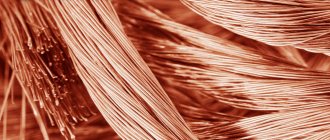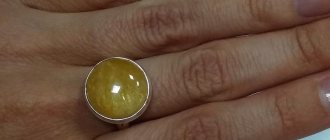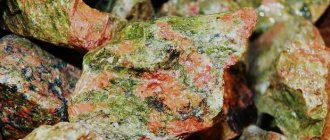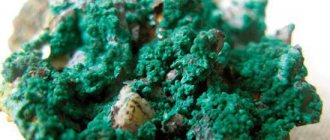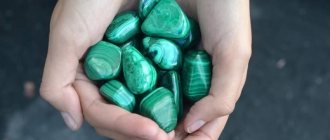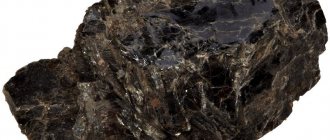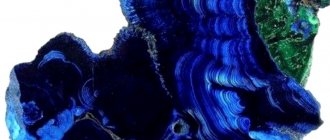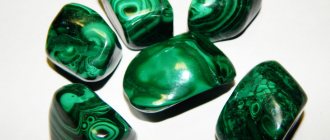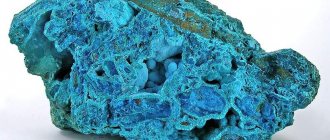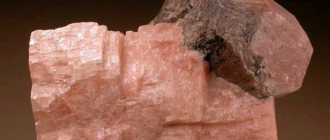Malachite
- a mineral, basic copper carbonate (copper(II) dihydroxocarbonate), the composition of which can be expressed by the chemical formula CuCO3*Cu(OH)2, corresponding to 72% copper oxide, 19.9% carbon dioxide and 8.1% water. Forms green masses of sintered shape with a radial fibrous structure. Used for crafts, previously used for copper mining. The largest modern deposits are located in Africa.
- Structure
- Properties
- Morphology
- Origin
- Application
- Classification
- Physical properties
- Optical properties
- Crystallographic properties
See also:
Malachite
– price and medicinal, magical properties
Physical properties and structure of diamond
STRUCTURE
Malachite is one of the main copper minerals, containing 57.4% pure metal. In addition to copper, it contains oxygen, carbon and water. In composition, malachite is an aqueous copper carbonate salt – Cu(OH)2·CuCO3. Malachite contains up to 72% copper oxide, which is why it was used as copper ore. Malachite crystallizes in a monoclinic system, a prismatic type of symmetry. The color of malachite is due to the presence of copper ion. As a result of the interaction of copper-sulfate solutions with carbonate or carbon dioxide waters, malachite is formed.
Who is malachite suitable for according to their zodiac sign?
Maximum disclosure of beneficial effects is possible if you know who malachite is suitable for and the properties of the stone. This is determined by zodiac compatibility. The gem's favorites are Taurus, Aries. Other signs will also feel the benefits.
The meaning of malachite from an astrological point of view:
- Aries. Reducing the manifestation of selfishness and stubbornness. Learning the ability to appreciate and understand others, to take into account their interests. Suppression of anger, aggression. Favorable effect on personal life and career.
- Calf. Help in finding the real cause of failures and life problems. Clarifying thoughts, giving a sober look at various situations.
- Scales. Ability to cope with mood swings. Eliminate fear and indecision. Giving women attractiveness, and men - charisma and masculinity.
- Sagittarius. Strengthening positive character traits. Empowering you with a desire to share knowledge with others. Becoming a great mentor or teacher, friend, parent or family man.
Compatibility of malachite with other signs of the Zodiac is observed. Pisces will learn to concentrate on the main things, think clearly and choose the right path. Capricorns will become reasonable and have healthy sleep. Aquarians will forget grievances from the past, they will get rid of unnecessary disappointments.
Malachite is ideal for creative individuals. To enhance the effect of the talisman, it is recommended to set the stone with copper or silver.
PROPERTIES
Hardness 3.5-4.0; density 3.7-4.1 g/cm³. The color of malachite varies from rich dark green to light turquoise green. It is opaque, translucent in small crystals. The gloss is matte, velvety, while in velvet it is silky. In dense kidney-shaped aggregates, color is usually distributed rhythmically, with alternating dark and light zones. Dense radiant aggregates have a beautiful silky shine. Fine-needle (corded) and powdery aggregates are uniformly colored.
When heated in a flask, it releases water and turns black. It is characterized by solubility in acids with the release of carbon dioxide, as well as in ammonia, which turns a beautiful blue color.
Malachite is one of the first semi-precious minerals that people began to use.
2. Ancient people believed that malachite has a direct connection with the forces of the Universe and conducts them to Earth. There were legends among the people that malachite could make a person invisible. 3. Copper was also obtained from it in ancient times.
4. In Rus', malachite was considered a stone that fulfills wishes. The Russian people have passed on a mystical legend that if you constantly drink from a malachite cup, you can learn to understand the language of animals.
5. The name of the stone comes from the Greek word “malakos”, which means “soft” in translation. According to another version - from mallow “malach” since the color of malachite resembles the color of the leaves of this plant
MALACHITE CURLY
6. Malachite is classified by the nature of the patterns on its surface. Malachite can be looped, ribbon, cockade, patterned, or flowing.
7.According to the quality of the stone, the following subtypes are distinguished: turquoise, velvet or fleece and curly.
8. Turquoise – the highest quality grade with the hardest structure, best suited for jewelry processing.
9. Velvet or fleece - has a high grain size, which makes it difficult to process.
10.Curly - a beautiful rare species with patterns that resemble the movement of birch foliage in the wind.
11. The unusual properties of malachite were noticed by people a long time ago. So, once, during a cholera epidemic in Egypt, people working in malachite mines were not harmed.
12.After this, the stone began to be used as an amulet against diseases. Later they began to make green paint and eye shadow from it. But when using the latter, a person developed mental disorders over time.
13. All this is due to the fact that malachite contains copper, which can accumulate in the human body with prolonged contact with the stone and cause harm.
14.But for the ancient Egyptians, malachite symbolized the goddess Hathor, the patroness of life and birth. Malachite pendants were given to newborns and hung over cradles to protect the child from the evil spirit and the evil eye. The Romans believed that malachite was capable of giving a person mutual love.
15. During the Middle Ages, malachite was considered a protector against the influence of black magicians. At the same time, people began to use malachite for decorating premises, creating jewelry and crafts. Now the Hermitage houses a collection of more than 200 malachite jewelry.
16. According to its chemical composition, malachite is the main copper carbonate, which contains impurities of silicon, phosphorus and calcium oxides.
17.The color of the stone can be found in both deep dark green and light turquoise green. It is opaque, only small crystals show through. Has a matte, velvety shine. Dense kidney-shaped growths are characterized by a striped color.
18. The hardness of malachite on the Mohs scale is 3.5-4, density is 3.9-4.1 g/cm3.
19.Crystals have a monoclinic system, needle-shaped or fine-prismatic shape. Dissolves in acids to form green solutions.
20. Malachite is found together with cuprites, chrysocolla, azurites, and copper phosphates. Its formation occurs through the interaction of solutions containing copper and carbonate rocks.
IN THE MINING MUSEUM OF THE CITY OF ANKT-PETERSBURG
21. Other names for the mineral and its varieties: plush malachite, satin ore, peacock stone, copper greens.
22. People have learned to use malachite since the Neolithic era. For a long time, it was mainly craftsmen who worked with it - dyers, glassblowers, painters, smelters.
23.Later they began to make jewelry. Archaeologists have discovered a malachite pendant that was created 10,500 years ago!
24. In Ancient Egypt, Ancient Greece and Rome, beads, cameos, amulets and other items, including those for decorative purposes, were made.
25. On the European continent, for many centuries, malachite treasures were owned exclusively by residents of Russia. And only in the 17th century did they really start talking about malachite all over the world. They looked for him everywhere. They decorated the offices of the most iconic people of the Russian Empire and Europe.
26.By the middle of the 18th century, malachite was officially classified as a valuable jewelry and ornamental stone. Thanks to its very bright and unique color, picturesque pattern and high polishability, malachite was used to make magnificent table lamps, luxurious vases, boxes, ashtrays and other furnishings.
URAL MALACHITE
27. Previously, Ural malachites were very famous and highly valued, but the mines, which were developed over four centuries, are now completely exhausted.
28. After all, for example, in the 19th century, approximately 80 thousand tons of malachite were mined there annually.
29. It was in the Urals that giant malachite blocks weighing 250 and 100 tons were discovered.
30. Malachite from copper deposits in the Urals near Yekaterinburg is especially valued - it was here that malachite was mined for facing fireplaces, tabletops, pilasters and vases in the Malachite Hall of the Winter Palace.
31.Ural malachites have two main varieties - turquoise malachite and plush malachite.
32. Turquoise malachite is the most valuable and most common. It differs in that the stripes of the pattern are located parallel to the concentric structure. The color palette is bluish emerald and turquoise stones. The turquoise type of malachite is divided, in turn, into finely patterned and ribbon subspecies.
PLEEVE MALACHITE
33. Plush malachite is distinguished by its radial-radiant structure, darker saturated shades, and stunning silky shine. This type of malachite is less easy to process and therefore less common.
34.The most famous is the Malachite Hall of the Hermitage, restored after a fire in 1837.
35. More than 200 malachite items are stored in the Malachite Hall of the Hermitage. In Russia in the 18th and 19th centuries, columns, pilasters, mantels, tabletops, large floor vases, clocks and other items in palace interiors were lined with malachite using the “Russian mosaic” method.
36. Columns made of malachite were installed in the altar of St. Isaac's Cathedral in St. Petersburg.
EXTRACTION OF MALACHITE FROM COPPER ORE DEPOSITS
37. Most often, the mineral is mined in the oxidation zones of copper ore deposits, which lie in limestone.
38. Malachite is a valuable industrial copper ore, but its value is limited, since accumulations of malachite are concentrated in the upper, quickly mined oxidized common copper deposits.
39. Dense sintered malachite with a beautiful pattern of zonal structure is a valuable ornamental stone for decorative and artistic products.
40. The turn in the history of malachite was due to the fact that in the Urals, against the background of thoroughly mined deposits of the world, Russia acquired an untouched and truly inexhaustible storehouse of copper and iron-copper ores.
41. Malachite is often called the “stone of health”; it is used for asthma, rheumatism, toothache, poisoning and depression.
42.Modern lithotherapy recommends the use of malachite for the treatment of diseases of the heart and lungs, pancreas and spleen.
43.The stone helps in tissue restoration, has a calming effect, and normalizes hormonal balance.
44. It is believed that the lighter the stone, the higher its healing properties.
45.According to American scientists, malachite is a good anti-radiation agent.
46. Malachite beads and pendants, as well as pyramids and balls, are used as medicinal products.
47. Malachite talismans enhance the charm and attractiveness of their owner.
48. The stone is set in copper to create amulets for creative people - musicians, poets and artists.
49.To attract success and recognition, artists are recommended to use malachites in a frame made of white metals: silver, platinum, aluminum.
50. Today, there are several ways to make fake malachite. For example, based on malachite chips, which are compressed pieces of low-quality malachite with paint impurities. Such products crumble easily and give stains from artificial coloring.
51.Fakes of malachite are made from glass. Glass is quite easy to paint green, but a similar example is easily distinguished by its transparency, as well as the absence of a unique pattern on the surface.
52. Malachite is also faked from plastic. When heated or in contact with a hot needle, such an imitation begins to melt, which will never happen with a natural mineral.
53. In order to distinguish a fake from another green stone, a drop of ammonia is applied to it. Real malachite turns blue. Under the influence of acids it begins to bubble, but such a test will irreversibly damage the natural sample.
MALACHITE rosary
54. Malachite rosaries are valued at $5 to $15. More complex processing of stone in beads leads to an increase in price up to 60-70 dollars. The cost of other jewelry depends on the setting and the work of the craftsman.
55. Products made from malachite must be protected from shock and sudden temperature changes. Acids and abrasives have a negative effect on this mineral. Such jewelry can only be cleaned in a cool soapy solution (no ultrasonic or steam treatment).
56.The largest deposits of malachite are located in the Congo. Samples from these deposits are distinguished by patterns in the form of small, regular-shaped rings.
57. Malachite is found in copper deposits in Romania, Australia, Chile, Zimbabwe, Namibia, USA (Arizona), England, Mexico, Russia (Ural), Kazakhstan.
58.Currently, the main supplier of malachite to the world market is Zaire (Kolwezi).
59.Despite its low hardness and instability, malachite is still one of the most popular jewelry and decorative stones today.
60. It is polished into cabochons or slightly convex tablets, beads are made from it, as well as small cabinet decorations, boxes or stands for candlesticks, watches, ashtrays and small figurines.
photo from the Internet
MORPHOLOGY
Well-formed crystals are very rare and always small, have a columnar, lamellar, needle-like appearance, and tend to split to form bundles, fluffy balls, spherocrystals, spherulites, spheroidolites and spheroidolite dendrites. Usually forms kidney-shaped fine-fibrous spherulite aggregates with a radial-radiating structure and concentric-zonal texture, spheroidolite cluster-shaped dendrites, pseudostalactites. Also leafy, dense or earthy in composition, sometimes in the form of parallel columnar aggregates (Dzhezkazgan deposit). The most characteristic and well-known are spherulitic fine-fiber concentric-zonal kidney-shaped aggregates (see photo). They grow from highly supersaturated nonequilibrium solutions.
Who should be wary of the stone?
It is not recommended to wear a malachite talisman for a long time. This awakens the animal’s natural essence in its owners. Logic, thinking and prudence stop working. The free expression of emotions, intuition, and instant reaction, conditioned more by instincts, will prevail over a person.
The gem is believed to be dangerous for women. Malachite attracts men, which, on the one hand, is good. However, the mineral is indiscriminate, so both good and bad people come into life. It turns out that a woman may end up in the hands of a not entirely decent man. Malachite in silver will help protect against this effect. This neutralizes negative intentions.
The mineral is not suitable for Cancers, Virgos and Scorpios. In the description of malachite, there is an opinion that the energy of these signs is not combined with the power of the stones. As a result, negative character traits increase, which leads not only to conflicts with loved ones, but also to danger to life.
ORIGIN
Malachite is formed exclusively in oxidation zones of copper sulfide deposits, especially if they occur in limestones or the primary ores contain a lot of carbonates. It is the most common copper mineral in oxidized copper ores. It develops both by replacing carbonates and by filling voids with the formation of typical collomorphic (sinter) forms in them. Since a clearly alkaline environment is created in solutions near the surface of limestones or carbonates of Ca and Mg, the solutions of copper sulfates that reach them obviously undergo hydrolysis, reacting with bicarbonate solutions.
In addition, copper carbonates can probably also arise as a result of the slow reaction of copper sulfate or hydrate with a solution saturated with atmospheric carbon dioxide.
Malachite often forms pseudomorphs after azurite, cuprite, native copper, and sometimes also after minerals such as atacamite, calcite, chalcopyrite, etc.
In Russia, malachite is known from the deposits of the Urals; in the CIS we also find it in Altai and Kazakhstan (Zhezkazgan). Rarely found in large masses. In Russia, the deposits are practically exhausted. The industrial malachite deposits Mednorudyanskoye in Nizhny Tagil and Gumeshevskoye in Polevsky are currently completely mined and closed.
The largest block of malachite weighing about 500 kg is located at the Mining Institute. According to G.N. Vertushkov, the discovery of new malachite deposits is possible in the Urals. Currently, reserves of malachite have been discovered only in one deposit - Korovinsko-Reshetnikovsky, with which hopes are pinned for the revival of the Ural malachite business.
Malachite varieties
The classification is based on the color of malachite, texture, and pattern. For a number of parameters, some varieties are valued higher than other specimens. Only stones of green shades are found in their pure form. Sometimes other colors are interspersed if foreign ores are mixed.
Varieties:
- velvet - velvet surface, fine-grained structure, the feeling after picking it up is reminiscent of touching velor or suede;
- finely patterned - a pattern on the cut reminiscent of birch leaves, many white veins and inclusions, found in the Urals, but rarely;
- radiant - green malachite with a dark tint, the structure is thin rays;
- ribbon - turquoise color, patterned in the form of twisting stripes with darker or lighter greenish tones;
- zonal-concentric - shades from rich green to turquoise, and a pattern in the form of swirls, strict rings (another name is a peacock eye);
- kidney-shaped - patterned, which is an alternation of stripes of light or dark shades of green.
When foreign metals are included, other malachite subspecies are formed. Cuprite - increased proportion of copper, a combination of green and red spots. Pseudomalachite is distinguished by its blue-green color. Aurichalcite is a subspecies with zinc and copper, which gives it a turquoise, sky blue color. Chrysocolla, or malachite flint, is another blue-green variety with matte edges.
APPLICATION
Dense varieties of good color and with a beautiful pattern are valued quite expensively and are used as an ornamental stone for making vases, inlays (lining tables, caskets) and other luxury items, as well as cabochons for inserts into small jewelry. The most amazingly sized items, lined with thin plates of malachite, can be considered the columns of St. Isaac's Cathedral in St. Petersburg. A large antique malachite vase of wondrous beauty adorns the center of the hall of the Mineralogical Museum. A.E. Fersman. Natural pigment is prepared from fine crumbs.
Since ancient Egypt, malachite ore has been used to produce copper.
Malachite – Cu2CO3(OH)2
| Molecular weight | 60.08 g/mol |
| origin of name | from Greek, malache, – “Mallow” (plant), due to the similarity of the color of the stone with green foliage |
| IMA status | valid, first described before 1959 (before IMA) |
How to distinguish a fake from a real stone
Malachite belongs to the inexpensive class, so it is rarely counterfeited. If this happens, glass or plastic are produced as analogues. Recently, stocks have begun to deplete, which has led to the emergence of more counterfeits.
How to understand that malachite is natural:
- hold it in your hands - the real nugget will remain cool, but the analogue will quickly heat up;
- swipe with a needle or glass - a mark or scratch will remain on the natural crystal;
- consider the pattern - stripes or ribbons on real gems cannot be even, identical and symmetrical.
Natural malachite stone, when examined under a magnifying glass, has various defects: chips, cracks, scratches. Counterfeits are distinguished by their perfect structure and structure. Counterfeits are usually brighter and more colorful, while natural specimens have a natural, muted color.
Nowadays they produce high-quality artificial stones. There are two types: pressed (from malachite chips) or synthetic (crystals grown in laboratory conditions). Sometimes small minerals are “glued” together with reagents, resulting in large specimens.
PHYSICAL PROPERTIES
| Mineral color | green, dark green, light green |
| Stroke color | light green |
| Transparency | transparent, translucent |
| Shine | glassy, silky, dull, matte |
| Cleavage | perfect by {201}, good by {010} |
| Hardness (Mohs scale) | 3.5 – 4 |
| Kink | uneven, close to conchoidal, splintered |
| Strength | fragile |
| Density (measured) | 3.6 – 4.05 g/cm3 |
| Radioactivity (GRapi) | 0 |
average price
Malachite is a semi-precious stone, so the price tag is very affordable. The final cost is influenced by the quality or complexity of processing, as well as the metal for the frame. An unusually beautiful set is popular - malachite in a ring and earrings.
- The cost starts from 2 thousand rubles.
- They charge about 5 thousand rubles for beads, which depends on the size and length of the product.
- A bracelet is sold for 1–2 thousand rubles, and earrings for 500–1000 rubles.
- The stone itself costs $5 per 1 gram.
OPTICAL PROPERTIES
| Type | biaxial (-) |
| Refractive indices | nα = 1.655 nβ = 1.875 nγ = 1.909 |
| Maximum birefringence | δ = 0.254 |
| Optical relief | very tall |
| Pleochroism | X - almost colorless, Y - yellow-green, Z - dark green |
| Dispersion | relatively weak |
| Luminescence in ultraviolet radiation | not fluorescent |
How to choose and wear malachite
It is better to buy a gem in spring or summer. Minerals that fall into your hands in autumn or winter will bring negativity. When choosing, you will need to focus on internal sensations and astrological meaning.
Wearing recommendations:
- put the ring or ring on the middle finger or little finger of the left hand;
- Wear bracelets and beads with malachite as you please, there are no special rules;
- take into account standard color combinations when choosing an image;
- protect from impacts, falls, compression, and other mechanical actions;
- Avoid the presence of the mineral during sudden temperature changes.
Rubies, pyropes, and diamonds do not go well with gemstones. Neighborhood with turquoise, chalcedony, jasper, jet, jadeite is considered optimal. It is not prohibited to wear malachites with opal, moonstone, sapphire, emerald or aventurine. Aquamarines and tourmalines are also suitable.
Caring for malachite consists of wiping with a soft cloth and a light soap solution. It is better to store the stone separately in a bag.
Malachite from the Urals
The stone, originally from the Ural Mountains, was known throughout the world; it captivated people with its beauty and gained incredible popularity in Europe. Despite the fact that the mineral was considered ornamental, it was eagerly used by jewelers to make various types of jewelry. The most popular, undoubtedly, were beads made of malachite. But you could also find:
- rings and bracelets;
- pendants and brooches;
- rings and necklaces.
As a rule, jewelry inlaid with this stone is massive, large and quite spectacular. Malachite is framed in both gold and silver. But the most beautiful items are those set in platinum or white gold - the cold color of the metal perfectly sets off the shine of malachite and makes it shine in the light of the sun and spotlights.
In the old days, bowls were made from this mineral; they were endowed with magical properties; it was believed that the dishes could teach a person to understand the language of animals.
Previously, the cost of jewelry with Ural malachite was very high; only a select few could afford to purchase such a product. But today the mineral is not of such value: depending on the weight of the jewelry and its setting, their cost may not exceed $100–200.
However, the stone is still valued by collectors, especially when it comes to antique items.
The popularity of malachite was also due to the fact that it was easy to process. It was possible to create both exquisite jewelry and quite familiar household items from it.
The density of the mineral ranges from 3.5 to 4 units on the Moss scale. Malachite is classified as a copper carbonate, which is why it is so often found when mining ore deposits. The color of the stone can be grass green or have a rich dark green tint. In general, the color palette is quite rich. It is worth noting that all minerals are decorated with a unique pattern.
But, in addition to beauty, Ural malachite has long been endowed with magical and healing properties.
Magic and astrology
Green stones were considered a talisman and a talisman; they were credited with a lot of properties that helped ordinary people cope with the hardships of life.
Sorcerers and magicians claimed that malachite would help:
- Become invisible.
- Will save you from fears and nightmares.
- Will help a woman get rid of her pregnancy.
- Makes a person believe in his own strength.
- It will calm and give harmony.
There are a huge number of legends that say that a mineral from the Ural Mountains can make a person invisible. It gives the owner the ability to disappear and appear in the right place at one time or another. In order to gain this gift, it is worth coming into contact with malachite and establishing a relationship with it.
Cups made of Ural malachite
The mineral was used as a talisman for children and adults. They tied him to the cradle, believing that malachite would protect the child. It will help your baby fall asleep and not suffer from nightmares and bad dreams at night. But an adult should put a stone under their pillow - it will help cope with insomnia and relieve anxiety and fears.
Healers recommended pregnant women to wear malachite beads. This stone was used during childbirth to ensure that a woman gave birth to a healthy baby and lost less blood. After birth, a cross made of this mineral was immediately put on the baby; it was considered a powerful talisman.
They say that a green stone helps to gain self-confidence. It forces a person to strive for a goal, achieve the desired result and overcome difficulties. This ability was in great demand among the population. They believed that malachite would certainly bring success and protect against failures and accidents.
Today the mineral is used as an element in spiritual practices. You can meditate on malachite; it makes sense to place the stone nearby - it will help you find harmony. The reason for everything is the color of the mineral, which gives a person peace of mind and helps to achieve enlightenment.
But malachite also has one more interesting feature - it attracts ill-wishers. When communicating with new people, you should be careful. The stone can attract envious people, but it will be difficult to recognize the ill-wisher.
Malachite absorbs the bad thoughts of other people and becomes dangerous. For this reason, the mineral needs to rest from time to time. To return the stone to its original properties, you should put it in a box, close the lid and do not touch it for several days.
According to astrologers, green stones have favorites; they favor certain zodiac signs.
Malachite from the Urals is suitable:
- Capricorns.
- Libra.
- Taurus.
The green color of the mineral carries the energy of the Earth - for this reason it is suitable for Capricorns. Representatives of this zodiac sign are calm and reasonable. But despite this, Capricorns are stubborn and prone to despondency; they are so fixated on achieving the goal that they sometimes lose sight of the main thing. Malachite will help Capricorns cope with melancholy and teach representatives of this zodiac sign to rejoice.
Malachite will help Libra overcome self-doubt. Representatives of this zodiac sign doubt everything: they question their own attractiveness, decisions made, and even obvious things. A green stone will help Libra make the right decision and no longer hesitate.
As for Taurus, representatives of this zodiac sign are fixated on material well-being. Taurus people love money and know how to spend it. So, jewelry with a stone will help representatives of this zodiac sign achieve material well-being, increase profits and find a goal. It should be worn regularly on your left hand.
But this mineral will not benefit Cancers and Scorpios. For this reason, representatives of these zodiac signs should admire malachite from afar.
Scorpios are distinguished by powerful energy; they are not able to obey the stone. For this reason, malachite will not help them. The mineral will change the character of Scorpio, making him harmful and irritable.
Cancers are highly emotional, creative and ambitious. Despite these qualities, they should not ask malachite for help. This stone will make Cancer nervous and push him to commit rash acts.
Ural malachite will not cause harm to everyone else, but there will be no benefit from it either. Jewelry with this mineral should not be worn regularly. It is worth wearing the products 2-3 times a week.
